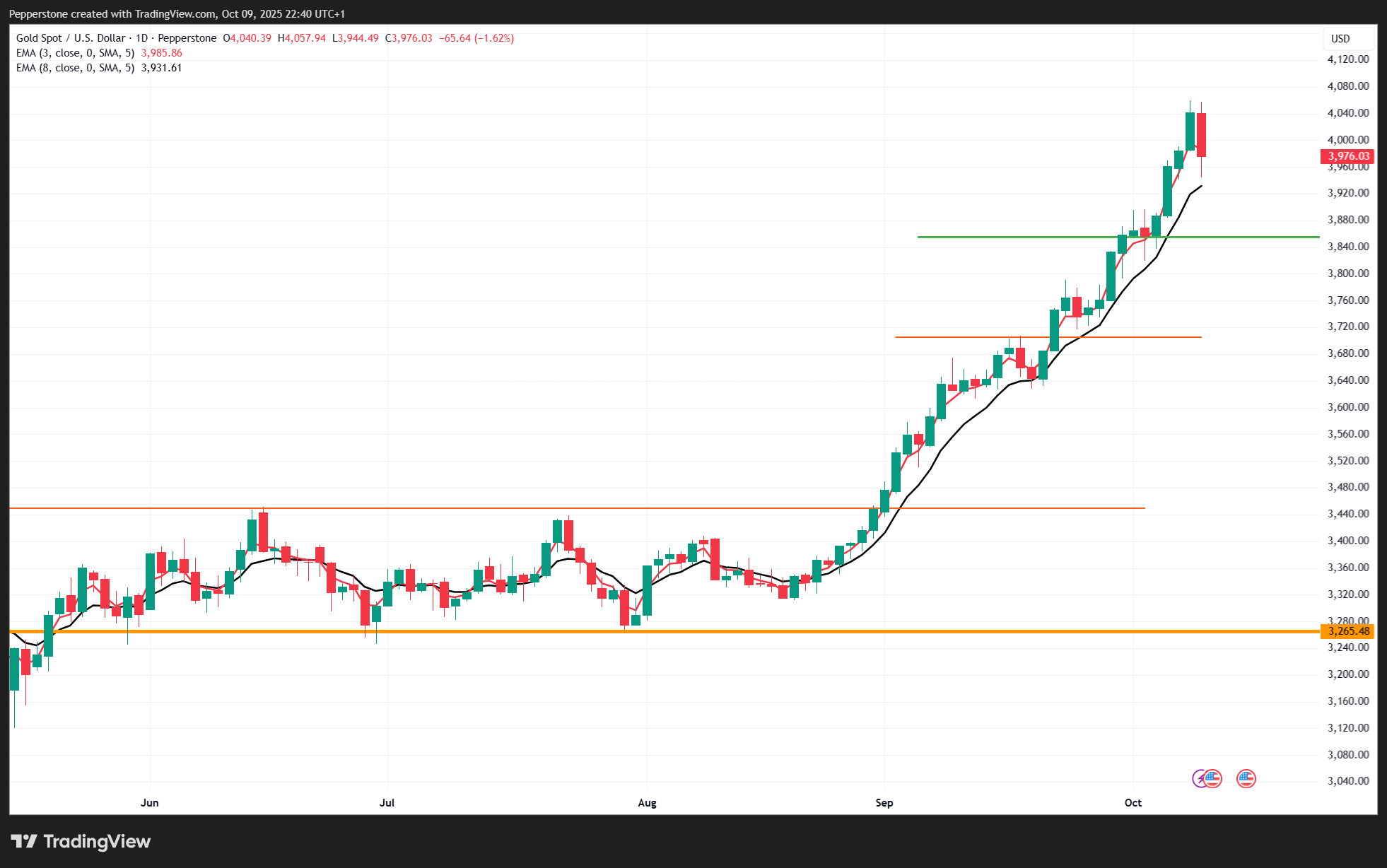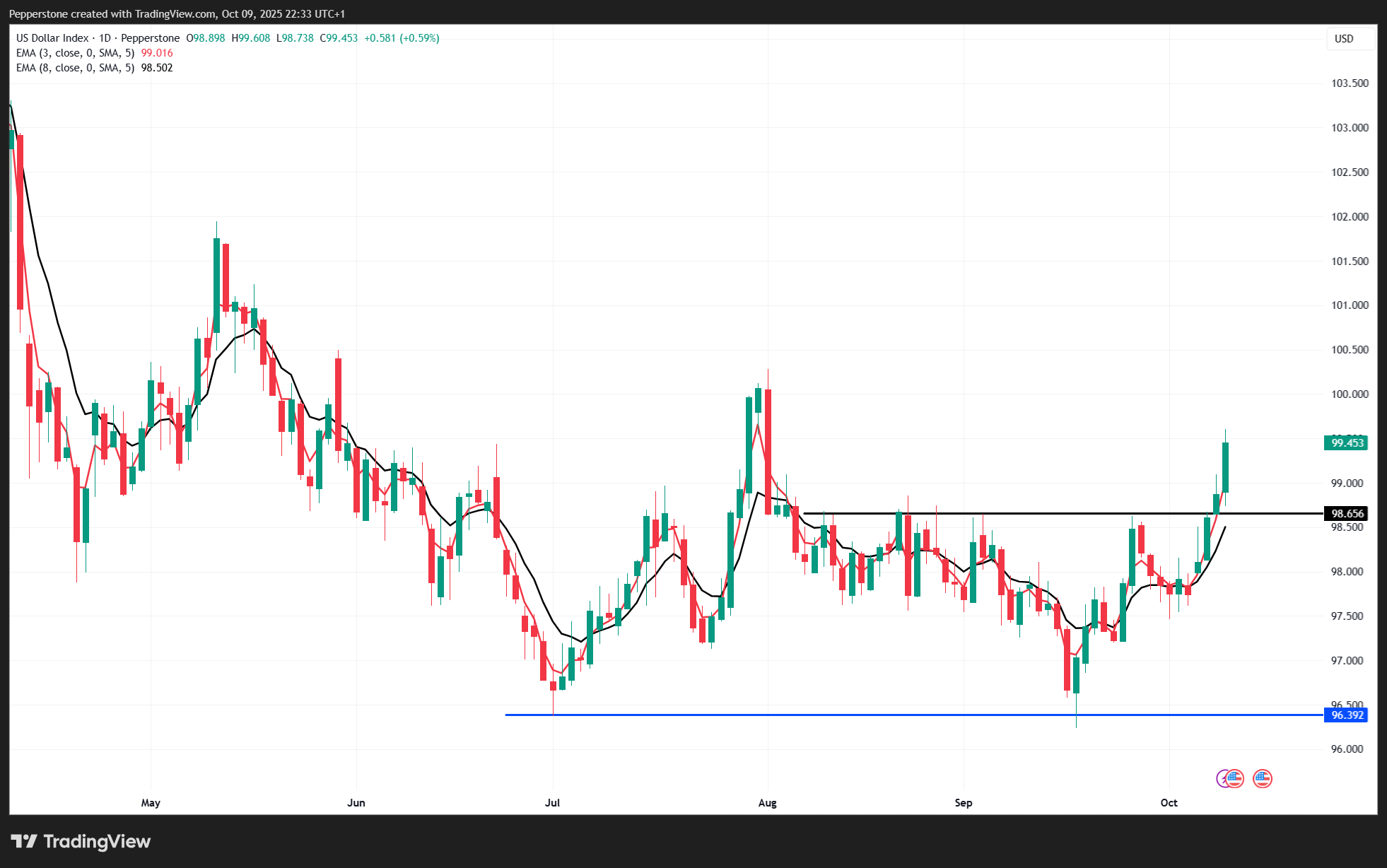- English
- عربي
Gold, Silver, and High-Momentum Trades Pause as USD Strengthens

Gold, silver, crypto, and much of the S&P 500 all moved as one through US trade—albeit with varied betas—as the technical picture showed evidence of the heat coming out of the move. The strong momentum that had delivered new highs day after day gave way, with some traders keen to reduce exposure from extended positions and lock in performance.
One swallow does not make a summer, and while Wednesday’s lows in silver and S&P 500 futures have been tested, they have importantly held, with intraday (dip) buyers still very much in the mix—for now. Little has changed fundamentally, and broad market sentiment hasn’t experienced any noticeable shift, with the volatility markets largely unchanged on the day. We can put this move down predominantly to a modest position adjustment, and while some will point to the Israel–Hamas peace truce as a catalyst behind the cross-asset moves, I remain unconvinced on that, as the news was known through Asia yesterday, and given the evolution of the market structure, markets just don't hold off for hours before reacting to news.
Moves in Silver on the day comes straight to mind, with silver (front-month) futures trading up to $49.96 before reversing 6.2% to $46.89. Futures volume picked up markedly on the move below $49.50, and while we’re still some way off CTA trigger levels (to reduce), the volumes on the day have been huge. Again, the silver lining for those still holding longs is that Wednesday’s low ($47.53) has held (so far), and the defence of $47.53 has been noted.

Gold futures pushed to a high of $4,077 (XAUUSD $4,057), and the reversal from this point was notable in that it failed to break above Wednesday’s high of $4,081. We then saw a strong dump of gold (front-month) futures longs that took price to $3,957. Unlike silver and S&P 500 futures, gold futures and XAUUSD closed the day below the prior session’s low, and that may be telling for a price action perspective—a further break below $3,957 in gold futures ($3,944 in XAUUSD) in the session ahead may subsequently trigger a further unwind of gross positioning.
S&P 500 and NAS 100 futures both traded lower through US cash trade, but the bid remains in the US equity market, with buyers stepping up at 6,760 (S&P500 futures) and pushing equities higher through the final two hours of cash trading. Nvidia has been a source of support for both equity indices, with price gapping higher on the open and trading to $195.30 in early cash trade. Despite the daily price action looking unconvincing, price has held the breakout, though there is now a gap to potentially fill into $189.60. Meta has also held up in a soggy market and supported the broader index, with staples the only S&P 500 sector closing in the green. Materials, industrials, and energy underperformed on the day—which won’t wholly surprise given the recent flows into these sectors—and the moves in precious metals and crude (-1.7%).

The USD has also been a clear talking point, with the DXY extending its recent technical break above the former range highs of 98.83, and a level that has contained the USD upside through August and September. EURUSD has naturally been at the heart of the DXY move, with the spot rate breaking 1.1600 with ease and falling to a low of 1.1542. The technical setup in EURUSD suggests this pair is now a seller’s market, with traders skewed to selling rallies, and options traders skewed to buying puts over calls. USDJPY also saw solid buying, with the spot rate now above 153, and the move now attracting greater attention from Japanese policymakers. Commentary from govt officials suggests 155 is the new “line in the sand,” that would run the increased prospect of MoF JPY jawboning/intervention, even if that was to vex Bessent and Trump, and the market may well look to test that level in the near term—particularly if expectations for a BoJ rate hike in December don’t build.
The recent USD rally has gone against market positioning and prompted a partial covering of USD shorts. There remains a high degree of skepticism that the USD can materially push through 100, a level in the DXY that was quickly reversed in May. USD longs have benefited from relative interest-rate expectations working in their favour, with USD forward rates (1y1y1 swaps) rising from 2.80% to 3.08%. While we remain in a US data vacuum given the ongoing shutdown, USD bulls will want to see forward rates rise above 3.15% and US 10-year real rates (currently 1.78%) climb to 2% to give them real conviction that the USD can break 100 and extend the trend higher.
The material provided here has not been prepared in accordance with legal requirements designed to promote the independence of investment research and as such is considered to be a marketing communication. Whilst it is not subject to any prohibition on dealing ahead of the dissemination of investment research we will not seek to take any advantage before providing it to our clients.
Pepperstone doesn’t represent that the material provided here is accurate, current or complete, and therefore shouldn’t be relied upon as such. The information, whether from a third party or not, isn’t to be considered as a recommendation; or an offer to buy or sell; or the solicitation of an offer to buy or sell any security, financial product or instrument; or to participate in any particular trading strategy. It does not take into account readers’ financial situation or investment objectives. We advise any readers of this content to seek their own advice. Without the approval of Pepperstone, reproduction or redistribution of this information isn’t permitted.